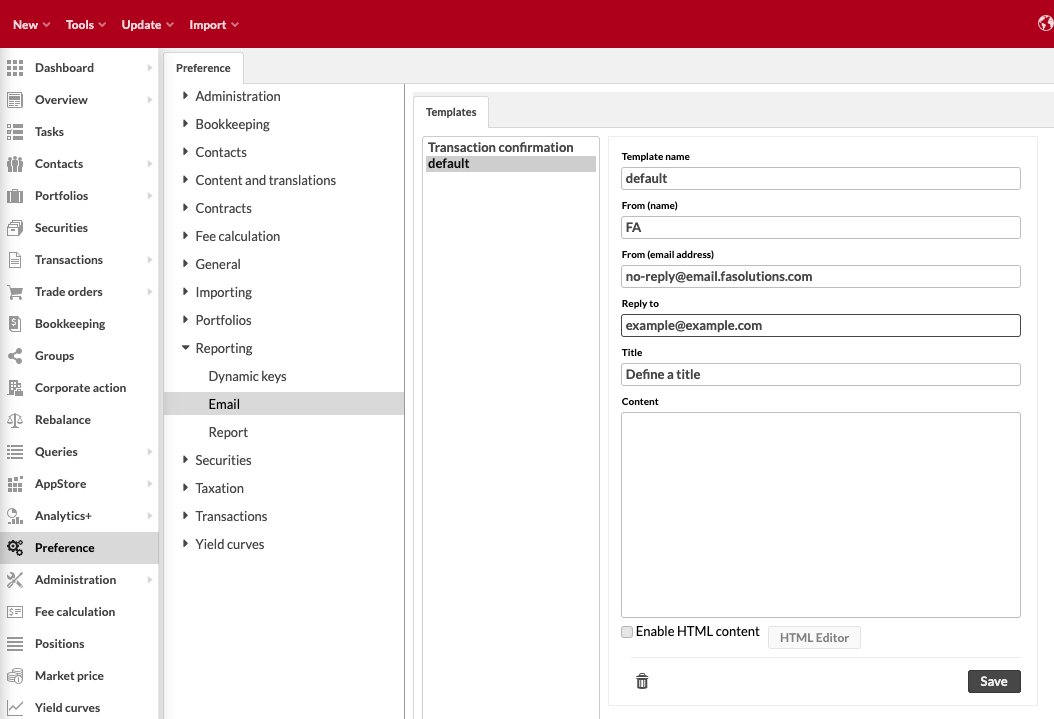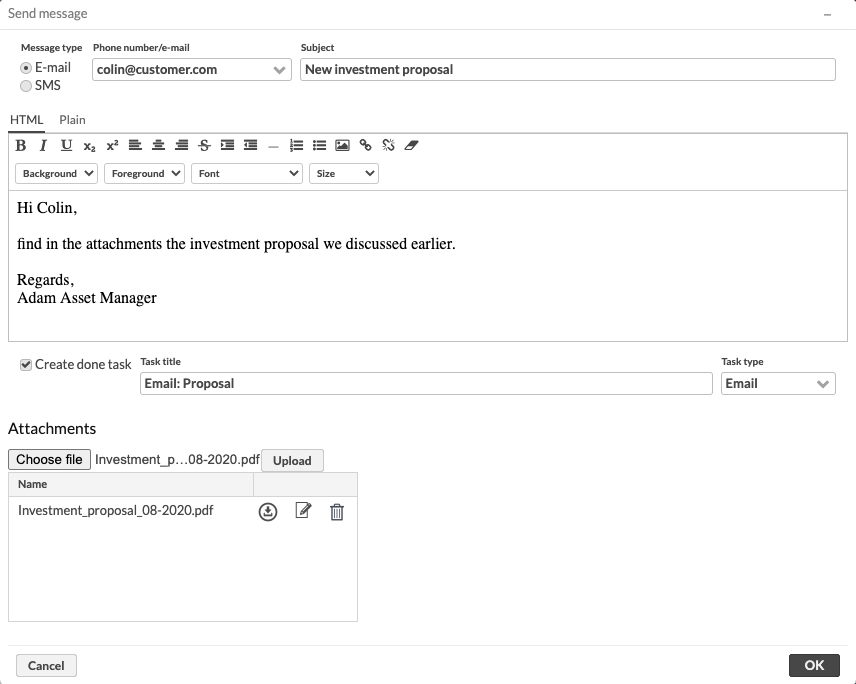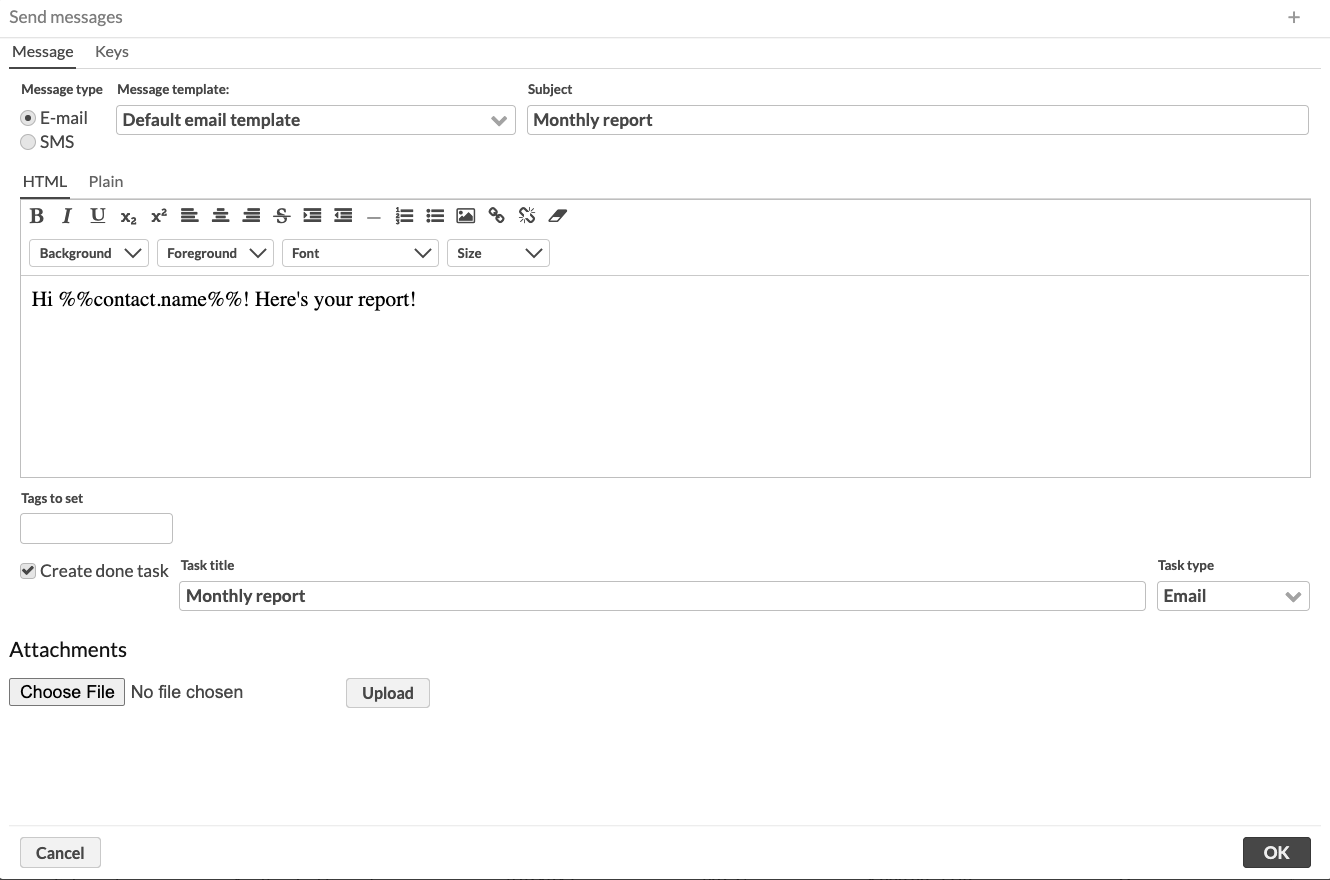Send and receive emails and SMS messages
Overview for sending messages
FA allows you to directly send and receive emails and SMS messages. All sent and received messages are stored within your other contact-related information, providing you with a record of all communication in one place. You can send messages one-by-one or mass-send messages to multiple contacts at once based on a search. In addition, you can send messages to contacts based on transactions or trade orders created for them.
Prerequisites for sending SMS messages
To use SMS messaging, you need to purchase a Twilio account and link it to the process configurations. You also need to define phone numbers on the contact level.
Prerequisites for sending emails
You can send emails to single recipients or mass-send emails to contacts based on a contact, portfolio, transaction, or trade order search. You need to have email addresses for your contacts defined in the Contact window, Addresses tab.
Add an email template
To send emails from the system, set up email templates. You can have multiple templates.
To add an email template, go to Preference → Reporting → Email and define the template values. When using the FA’s email server (default setting), the sender email must be no-reply@email.fasolutions.com. Other values can be defined as needed.
 |
Configure the default email template and recipient
You can choose which email template is used by default and which contacts the emails for portfolios, transactions, and trade orders are sent to. Go to Tools → Administer → Communications and fill in the fields:
E-mail template name (as defined in the previous section under Template name) for each of the views that you can send emails from (Contacts, Portfolios, Transactions, and Trade orders). The template you choose is pre-selected in manual runs and directly used in scheduled runs.
Portfolio contacts to send e-mails. Select primary contact only, all contacts, portfolio asset managers or primary contact representatives. This selection is applicable when sending emails for portfolios, transactions, or trade orders. For contacts, it is always the contact itself.
Schedule emails
To schedule email sending against a saved view, follow the instructions for Scheduling processes in the FA Admin Guide. Keep in mind that the default email template is always used in scheduled runs. See the section Configure the default email template and recipient .
Send messages to one recipient
To send an email or SMS message to a single contact, go to Overview, right-click the contact in the Portfolio hierarchy, and select Reporting → Send messages. You can also right-click a portfolio and make the same selection. Fill in the fields in the Send message window which are described below.
- Message type
Email or SMS.
- Phone number/e-mail
The email address or phone number you want to send your message to. The available options are automatically fetched from the selected contact's address information.
- Subject
Message subject (available for emails only).
- Message content
Message content either in HTML (available for emails only) or plain text. The built-in editor helps you add HTML markup to your emails.
- Create done task
If you want to track what emails that have been sent, you can choose to automatically record sent emails. Enable the functionality, define a title for your task, and select the task type. If the title is left empty, the message subject or fixed text "SMS" is used as the title of the created task.
- Attachments
Upload message attachments (available for emails only).
 |
Send messages to multiple recipients
You can also send emails or SMS messages simultaneously to multiple contacts based on a contact search on Contacts view or Customers view or based on transactions or trade orders created for your contacts.
When mass sending emails, you can define your message subject and content with dynamic text, filling in data from the contact the email is sent to. This allows you to personalize the emails. For example, you can include the email recipient's name within the content. In addition, when mass-sending messages, email addresses, and phone numbers are automatically fetched from the contacts. The email address or phone number is retrieved from the first address with this information available. If no email address or phone number is found, the message cannot be sent.
To send the same email to several contacts, use the Contacts, Portfolios, Transactions , or Trade orders view. Find the contacts, portfolios, transactions, or trade orders by searching, and click Reporting → Send messages. Define the message subject and content. Choose if you want to store the message in the contacts' Tasks as well.
Note
Emails are sent to the email addresses defined for the selected contacts when running from the Contacts view. In the other views, contacts are found via the portfolio. Follow the instructions in the Configure the default email template and recipientto define which contacts are used.

Receive emails and SMS messages
You can automatically record inbound emails and SMS messages. Messages received by a specific email address or phone number can be recorded as a task. If a matching email address or phone number can be found stored on a contact in the system, the inbound message task is linked to the matching contact. Email attachments are also automatically saved into the matching contact's documents.
 |
Received emails and SMS are shown in the task lists in the Tasks view. Messages are shown either as "open" tasks or "completed" tasks, depending on whether the email originates from a contact or is forwarded from within your organization (you can configure the list of domains or email addresses belonging to your organization). If an email originates from within your organization, it is automatically saved as a "completed" task. Otherwise, the email is shown as an "open" task. SMS messages are always shown as "open" tasks.
When you open a "Read message" from a task list showing open tasks, you can read the message, check the attachments, and then choose to disregard it (Cancel), reply to it by sending a message (Reply), or save it under the corresponding contact without replying (OK). The corresponding contact is automatically determined based on the email address or phone number the message originates from. You can see this information at the top of the open message.